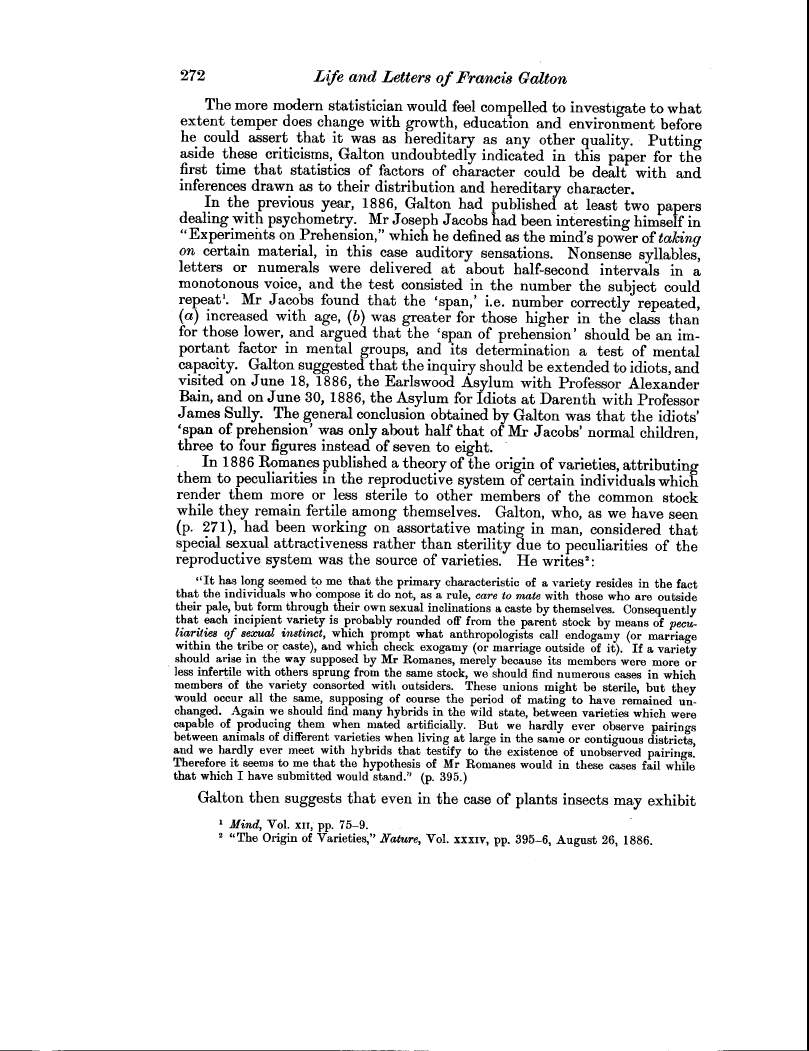272 Life and Letters of Francis Galton
The more modern statistician would feel compelled to investigate to what extent temper does change with growth, education and environment before he could assert that it was as hereditary as any other quality. Putting aside these criticisms, Galton undoubtedly indicated in this paper for the first time that statistics of factors of character could be dealt with and inferences drawn as to their distribution and hereditary character.
In the previous year, 1886, Galton had published at least two papers dealing with psychometry. Mr Joseph Jacobs had been interesting himself in "Experiments on Prehension," which he defined as the mind's power of taking on certain material, inn this case auditory sensations. Nonsense syllables, letters or numerals were delivered at about half-second intervals in a monotonous voice, and the test consisted in the number the subject could repeat'. Mr Jacobs found that the `span,' i.e. number correctly repeated, (a) increased with age, (b) was greater for those higher in the class than for those lower, and argued that the `span of prehension' should be an important factor in mental groups, and its determination a test of mental capacity. Galton suggested that the inquiry should be extended to idiots, and visited on June 18, 1886, the Earlswood Asylum with Professor Alexander Bain, and on June 30, 1886, the Asylum for Idiots at Darenth with Professor James Sully. The general conclusion obtained by Galton was that the idiots' `span of prehension' was only about half that of Mr Jacobs' normal children, three to four figures instead of seven to eight.
In 1886 Romanes published a theory of the origin of varieties, attributing them to peculiarities in the reproductive system of certain individuals which render them more or less sterile to other members of the common stock while they remain fertile among themselves. Galton, who, as we have seen (p. 271), had been working on assortative mating in man, considered that special sexual attractiveness rather than sterility due to peculiarities of the reproductive system was the source of varieties. He writes2:
"It has long seemed to me that the primary characteristic of a variety resides in the fact that the individuals who compose it do not, as a rule, care to mate with those who are outside their pale, but form through their own sexual inclinations a caste by themselves. Consequently
that each incipient variety is probably rounded off from the parent stock by means of peculiarities of sexual instinct, which prompt what anthropologists call endogamy (or marriage within the tribe or caste), and which check exogamy (or marriage outside of it). If a variety should arise in the way supposed by Mr Romanes, merely because its members were more or less infertile with others sprung from the same stock, we should find numerous cases in which members of the variety consorted with outsiders. These unions might be sterile, but they would occur all the same, supposing of course the period of mating to have remained unchanged. Again we should find many hybrids in the wild state, between varieties which were capable of producing them when mated artificially. But we hardly ever observe pairings between animals of different varieties when living at large in the same or contiguous districts, and we hardly ever meet with hybrids that testify to the existence of unobserved pairings. Therefore it seems to me that the hypothesis of Mr Romanes would in these cases fail while
that which I have submitted would stand." (p. 395.)
Galton then suggests that even in the case of plants insects may exhibit
' Mind, Vol. xii, pp. 75-9.
2 "The Origin of Varieties," Nature, Vol. xxxiv, pp. 395-6, August 26, 1886.

